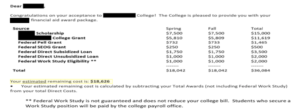
College affordability shouldn’t be a one-time calculation done at the time a student receives their first financial aid award letter. Reducing the cost of college – and thereby increasing the return on investment – can be done in college. One way: reduce student loan borrowing (or begin repayment early) by earning money from the Federal Work-Study Program or with a part-time job. Every dollar earned is potentially one less dollar that needs to be borrowed!
The Federal Work-Study Program is not a grant or scholarship (free money) or a loan, program. It is earned aid, offering students part-time jobs, generally on campus. Colleges include Federal Work-Study as part of a student’s need-based aid on the financial aid award letter – the example below shows that the student is eligible to earn up to $1,000/semester.

Parents should be sure that students understand two very important facts about the Federal Work-Study Program:
- It does not reduce the amount that needs to be paid when the college bill comes due. It is simply a guaranty that the student may earn this aid over the course of the academic year.
- Students do not have to accept the work-study award. They may be able to find another part-time job that pays more, is in their field of interest or offers more flexibility.
Having said that, the Federal Work-Study Program is specifically designed to help students and is a much-needed source of income for students.
Most work-study jobs are campus-based. Applying for one is generally just like applying for any other job. Often colleges have jobs listed exclusively for work-study students. Work-study jobs might be found on the college’s website or students may check-in with the financial aid office to see what’s available. Often work-study positions are spread out among several different departments, so students might find one in their area of interest. In addition to earning money, work-study is a terrific networking opportunity to meet other students, professors and professionals with similar interests. For example, work-study jobs may include working in a lab, the library or dining hall, or managing the front desk at a student union building, or assisting in an office. Most often clerical work is available including data processing, filing and directing phone calls, but it is an opportunity to gain some experience in the workplace.
Some work-study jobs may be off campus, often in conjunction with a community outreach or charity program that supports the local neighborhood or at-risk communities.
A Federal Work-Study student is paid at least the greater of the federal, state or local municipality minimum wage. The current federal minimum wage is $7.25 per hour, but many states and municipalities have significantly higher minimum wages. Most students work between 8-10 hours per week with a maximum of 20 hours.
Only students receive a work-study award as part of their need-based financial aid award. Colleges use the Free Application for Federal Student Aid (FAFSA) to determine financial need so the first step for students is to file the FAFSA as soon as possible. Check out these 5 Tips for filing the FAFSA from the My College Corner Blog. The amount of a student’s award (and whether or not you receive one) depends on when the student applies, the school’s funding level, and the student’s financial need.
Students who aren’t awarded a work-study job, or have one that does not pay well, should consider a regular part-time job as a way to earn money and potentially reduce student loan debt. In addition to earning some income, students who work even a few hours a week while going to school will gain some experience, learn valuable skills involved in managing their time and money.